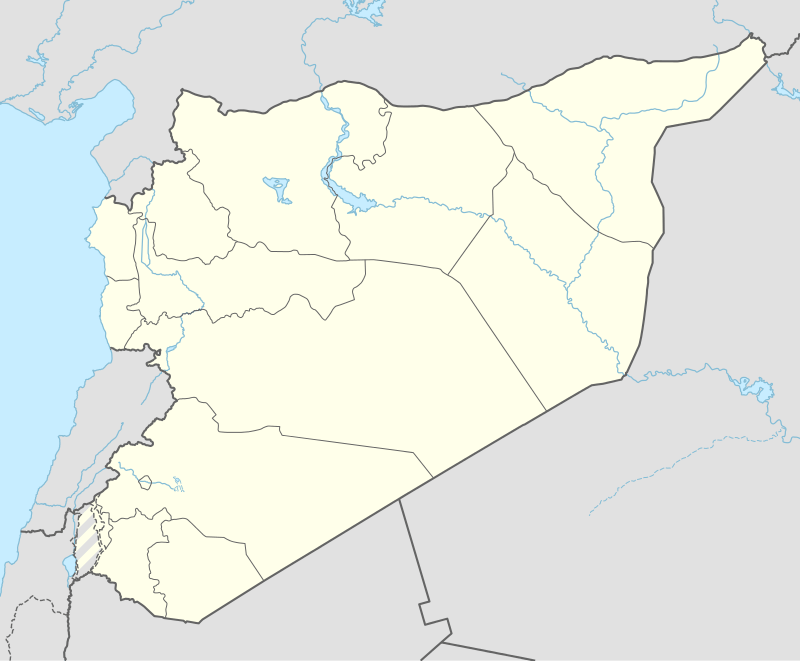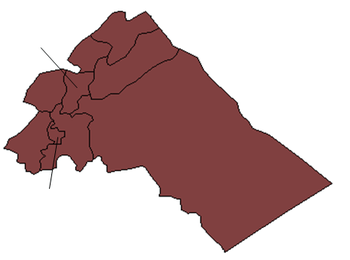Rakhlah
Rakhlah (Arabic: رخلة; also spelled Rakhleh or Rakhlé), previously known as Zenopolis,[3] is a village situated 31 kilometres (19 mi) west of Damascus, Syria.[4] also known as "The town of Wine and Poetry".
Rakhlah رخلة Rakhleh, Rakhlé, Zenopolis | |
|---|---|
Village | |
 Rakhlah Location in Syria | |
| Coordinates: 33°30′59″N 35°58′22″E | |
| Country | |
| Governorate | Rif Dimashq Governorate |
| District | Qatana District |
| Nahiyah | Qatana |
| Elevation | 1,550 m (5,090 ft) |
| Population (2004 census)[2] | |
| • Total | 368 |
| Time zone | UTC+3 (EET) |
| • Summer (DST) | UTC+2 (EEST) |
According to the Syria Central Bureau of Statistics, the village had a population of 368 in the 2004 census.[2] The population is predominantly Druze.[5] The main family is Abou Kheir,
Ancient history
In Late Antiquity, the city was known as Zenopolis (Greek: Ζηνούπολις), in the Roman province of Phoenice Paralia (or "Phoenicia Prima"). It became a city and a bishopric at the end of the 5th century.[6]
Rakhlah is a possible location of the bishopric of "Rachlea"[7][8] included in the Catholic Church's list of titular sees.[9] In his account of this bishopric, which he calls that "of the Rachlenes" (Latin Rachlenorum, Greek Ραχληνῶν), Le Quien says that, at a provincial synod held at Tyre in 518, Elias, spoken of in the acts as Bishop of the Rachlenes, signed as Ἠλίας ἐπίσκοπος Ζηνουπόλεως (Elias Bishop of Zenopolis); and that the acts of the Second Council of Constantinople in 553 bear the signature of "Anastasius by the mercy of God Bishop of the Rachlenes in the province of the Tyrians".[10]
Ancient temples
There are the ruins of two Roman-Phoenician temples in the village that are included in a group of Temples of Mount Hermon.[3][11][12] The smaller, apsidal temple was cut out of bedrock. The other, larger temple may have been used as a church and is constructed of enormous blocks of limestone; it measures 82.5 feet (25.1 m) by 57 feet (17 m). It features two rows of ionic columns that run along the walls from the entrance to a semi-circular altar.[13] One of the walls of the temple is adorned with a relief of the face of a sun god, possibly Ba'al[14] within a wreath that is aligned to look at Mount Hermon and measures 40 inches (100 cm) in diameter.[15][16] Two stones close to the gate show depictions of a bird with outstretched wings that was suggested to have been part of the temple's architrave. The carving was described as "essentially Assyrian in character" by Edward Robinson when visiting the site in 1852. He further suggested that the stone was brought to the site from a far distance. He considered the construction of the temples was likely to have taken place "many centuries before the Christian era". He noted several Greek inscriptions and took some copies.[14] The epigraphic information derived from the inscriptions at Rakleh has supported the existence of a local settlement and given details of the names and positions of the temple officials.[17] One of the texts starts with the invocation "to the Good Fortune". It is also known from the inscriptions that the Greek goddess of the sea, Leucothea, was worshipped in the temple from 60 CE onwards. Two of the texts show that the officials exercised an unspecified authority. They detail the restoration of the temple using funds, implying they owned estates or assets earning interest. A building constructed in 253 CE was said to have been paid for "at the expense of the goddess taken from the interest". The treasurers of the temple also funded a new door in 379 CE.[3]
A few other rock cut tombs and caverns have been noted around the area.[5][18]
References
- http://www.al-amama.com/index.php?option=com_content&task=view&id=1662
- General Census of Population and Housing 2004. Syria Central Bureau of Statistics (CBS). Rif Dimashq Governorate. (in Arabic)
- Ted Kaizer (2008). Aliquot, Julien., Sanctuaries and villages on Mount Hermon in the Roman period in The Variety of Local Religious Life in the Near East In the Hellenistic and Roman Periods. BRILL. pp. 76–. ISBN 978-90-04-16735-3. Retrieved 17 September 2012.
- Ross Burns (20 January 2005). Damascus: A History. Taylor & Francis. pp. 78–. ISBN 978-0-415-27105-9. Retrieved 18 September 2012.
- Transactions. 1868. pp. 216–. Retrieved 20 September 2012.
- Kaizer, T. (2008). The Variety of Local Religious Life in the Near East: In the Hellenistic and Roman Periods. Brill. ISBN 9789004167353. Retrieved 28 March 2016.
- David M. Cheney, Rachlea at Catholic hierarchy 1996–2015.
- The diocese of Rachlea is in the Provence of Fenicia I and under Bishop of Tiro. It should not be confused with Roman Catholic Archdiocese of Regina.
- Annuario Pontificio 2013, p. 957
- Quien, M.L.; Imprimerie Royale (París) (1740). Oriens christianus: in quatuor patriarchatus digestus : quo exhibentur ecclesiae, patriarchae caeterique praesules totius orientis. ex Typographia Regia. Retrieved 28 March 2016.
- Cymmrodorion Society (1890). Y Cymmrodor. Cymmrodorion Society. Retrieved 20 September 2012.
- Daniel M. Krencker; Willy Zschietzschmann (1938). Römische Tempel in Syrien: nach Aufnahmen und Untersuchungen von Mitgliedern der Deutschen Baalbekexpedition 1901–1904, pp. 205-269 & pl, 83-116, Otto Puchstein, Bruno Schulz, Daniel Krencker. W. de Gruyter & Co. Retrieved 17 September 2012.
- Victor Guérin (2005). Mission au Liban: description géographique, historique et archéologique ... accompagnée de gravures ... Librairie Antoine. Retrieved 20 September 2012.
- Charles Wilson (3 June 2010). Picturesque Palestiine, Sinai and Egypt. Sophia Perennis et Universalis. ISBN 978-1-59731-459-6. Retrieved 19 September 2012.
- Albert Leighton Rawson (1870). The Bible Handbook: For Sunday-schools and Bible Readers. With 150 Engravings and 25 Maps and Plans. R.B. Thompson. pp. 87–. Retrieved 20 September 2012.
- A. H. Sayce (April 2004). The Early History of the Hebrews. Kessinger Publishing. pp. 327–. ISBN 978-0-7661-8991-1. Retrieved 20 September 2012.
- "Di Segni, Leah., On a dated inscription from Rakhle and the eras used on the Hermon Range, in Zeitschrift fur Papyrologie und Epigraphic 117, pp. 277-280, 1997" (PDF). uni-koeln.de. Retrieved 28 March 2016.
- Karl Baedeker (1876). Palestine and Syria, handbook for travellers. Karl Baedeker, Dulau. Retrieved 20 September 2012.
